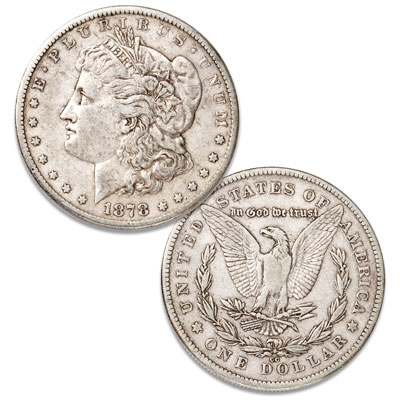
When it comes to US coins, the dollar is arguably the most popular denomination that people collect. First issued by the United States of America in 1794, there have only been a handful of designs released into circulation throughout history. Some designs and varieties (such as the Morgan Dollar for example) are extremely rare and highly sought after by collectors, while others are simply valued for their precious metal content.
Silver Dollar Guide and Values
Below is a complete list of each circulating dollar coin that has ever issued by the United States Mint:
– Flowing Hair Dollars (1794-1795)
– Draped Bust Dollars (1795-1803)
– 1804 Dollar (1803)
– Gobrecht Dollars (1836-1839)
– Seated Liberty Dollars (1840-1873)
– Trade Dollars (1873-1885)
– Morgan Dollars (1878-1904, 1921)
– Peace Dollars (1921-1928, 1934, 1935)
– Eisenhower Dollars (1971-1978)
Even though most of the dollars that have been put into circulation during the modern era are generally comprised of cheap base metals and produced in vast quantities, most older dollar coins that were minted before 1965 were made of precious metals (primarily silver) and were made in more limited quantities. For example, the Sacajawea dollar has a golden appearance, but is primarily comprised of Copper and over one billion coins were minted during its first year in circulation. Alternatively, US coins from the 1800s and early 1900s – such as the Morgan, Peace and Trade dollars – were minted in much more limited quantities (sometimes less than one million per year), contain 0.900 fine silver, and are still widely collected both in the United States and abroad to this day.
History of Dollar Coinage in the United States
The dollar began being issued as currency in the form of coinage by the United States Government shortly after the US Mint was established in 1792. The first dollars were minted two years later in 1794, however, only a mere 1,750 coins saw circulation. The following year, in 1795, more than 160,000 coins were minted and used in circulation by American citizens of the time. Dollars have been struck virtually every year since that time, and today there are thousands upon thousands of different designs, mintmarks, years and varieties to collect.
Since the first dollar coin was authorized and minted in the 1790s, the United States has typically produced them in 90% silver. The last traditional “silver dollar” was the Peace Dollar, which was only minted for a short period of time (1921 to 1935). There were no dollar coins issued after production of the Peace Dollar was ceased in 1935.
In 1978 the Eisenhower Dollar was introduced – however, in 1965, the United States removed silver from a majority of its circulating coinage so the Eisenhower Dollar does not contain any real silver. Since 1935 most dollars have been struck in nickel, copper and/or other base metals.
Starting in 1986, the US Mint began offering 1 oz silver coins as both a collectors item and a silver investment. The American Silver Eagle, as it is called, has been minted each year since 1986 and contains 1 troy ounce of .999 pure silver. Even though it is assigned a $1 USD face value, the coin is bought and sold based on its precious metal content.
Circulating US silver dollar coins have historically been struck at a number of different US Mint locations, including:
– Denver, CO (D)
– Philadelphia, PA (No mintmark)
– San Francisco, CA (S)
– New Orleans, LA (O)
– Carson City, NV (CC)
Most Popular Silver Dollars
When you look at all of the silver dollars minted by the United States since the 18th century, the most popular variety among collectors has to be the Morgan Dollar. With approximately 98 different date and mintmark varieties, it is also one of the largest silver dollar sets that collectors can build. Many collectors can spend a lifetime trying to fill in their collection of morgan dollars, and it’s not an easy task.
With hundreds of millions of coins struck during its 27 year circulation period, they are still widely available on the secondary market today. Depending on the condition, mintmark and year, you can find Morgan Dollars for as little as $30. However, more scarce varieties can sell for $100,000 or more in today’s market depending on condition and rarity.
Rarest Silver Dollars
There are a number of rare silver dollars that are highly prized among collectors. Many times, the rarity is attributed to a coin’s low population — either not many coins were minted during a specific year or at a specific mint, or they were melted or destroyed and not many still exist. Below is a list with some of the Rarest silver dollars available today.
1893-S Morgan Dollar
With only 100,000 Morgan Dollars produced at the San Francisco Mint in 1893, and many of them being used in circulation, this is one of the toughest silver dollars to find, especially in high quality. The 1893-S Morgan Dollar is considered a key date in the series and is among the rarest silver dollars as a whole.
1895 (P) Proof Morgan Dollar
The 1895 Proof Morgan Dollar is the holy grail for any serious silver dollar collector. The US Mint did not strike any Morgan Dollars for circulation at the Philadelphia branch in 1895, however, 880 Proof coins were struck. Out of the 880 coins minted, it is believed that only around 400 still exist today. Even though that mintage number is in line with proofs from other years, the fact that no business strikes were minted at Philadelphia means that in order to get a Philadelphia minted coin from 1895, collectors need to acquire the proof variety.
As one of the most sought after silver dollar varieties, there are thousands of collectors completing for a mere 400 coins. For that reason, 1895 Proof Morgan Dollars can sell for anywhere from $35,000 in poor condition to well over $100,000 for coins that are in PR64 grades and higher.
Collecting Silver Dollars
When collecting silver dollars, you can go in a few different directions. One of the most popular methods is to focus on one series and collect one coin from each year that it was minted. This is commonly referred to as a “date set” and is one of the most affordable ways to build a set of silver dollars.
To build a tried-and-true “complete” set of silver dollars, you would need one coin from each year that it was minted from each different mint. The only downside to building a complete set of a silver dollar series is the cost. Depending on the value of rare varieties and low mintage years/mints in a set, building a complete set of silver dollars can be unobtainable for the average collector.
The last option when it comes to building a set of silver dollars would be to acquire one coin from each different series, which is called a type set. When people choose to build a type set, they usually acquire coins in a higher quality since the set will contain less coins versus building a date set or a complete set.
No matter which type of set you decide to build, coin collecting can be a great hobby and coins are one of the most popular things to collect in the United States.
Gold Dollars
When it comes to collecting coins, silver dollars usually get all the attention and overshadow other types of coins. For the average person – and even a lot of novice collectors – they may not know that the United States minted dollars out of gold. As the California Gold Rush was in full swing in the mid-1800s, the United States began minting dollar coins in gold.
The US Gold Dollar was issued by the Government from 1849 to 1889 and consisted of a 90% gold and 10% copper mix. There were three variations issued during its time in circulation, which are referred to simply as Type I (1849-1853), Type II (1854-1855) and Type III (1856-1889). Each type of gold dollar is slightly different in terms of design and size, but are generally pretty similar.
These coins were much smaller than silver dollars for obvious reasons, and were about the size of a modern dime. Production was ceased eventually in 1889.
